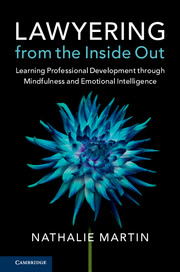 Lawyering from the Inside Out
Lawyering from the Inside Out Book contents
- Frontmatter
- Dedication
- Contents
- List of Figures
- List of Contributors
- Foreword
- Acknowledgments
- Introduction
- PART I NURTURING YOUR BEST SELF
- PART II YOU AND OTHERS AROUND YOU
- 9 Introduction to Emotional Intelligence: Theory and Practice
- 10 Advanced Emotional Intelligence Skills
- 11 Emotional Intelligence on the Page: The Writer's Life
- 12 Giving and Receiving Feedback
- 13 Empathy
- 14 Cross-Cultural Lawyering
- 15 Making Mindful, Client-Centered Decisions
- PART III YOU AND SOCIETY: FINDING GREATER PURPOSE
- Index
15 - Making Mindful, Client-Centered Decisions
from PART II - YOU AND OTHERS AROUND YOU
Published online by Cambridge University Press: 18 May 2018
- Frontmatter
- Dedication
- Contents
- List of Figures
- List of Contributors
- Foreword
- Acknowledgments
- Introduction
- PART I NURTURING YOUR BEST SELF
- PART II YOU AND OTHERS AROUND YOU
- 9 Introduction to Emotional Intelligence: Theory and Practice
- 10 Advanced Emotional Intelligence Skills
- 11 Emotional Intelligence on the Page: The Writer's Life
- 12 Giving and Receiving Feedback
- 13 Empathy
- 14 Cross-Cultural Lawyering
- 15 Making Mindful, Client-Centered Decisions
- PART III YOU AND SOCIETY: FINDING GREATER PURPOSE
- Index
Summary
Good decision-making, particularly in a service profession where decisions are made for the benefit of another, is critical to good lawyering. While claims ultimately make their own decisions, in many complex legal settings clients can only decide with the thoughtful help of their clients. In reality, lawyers make hundreds of decisions a week, many on behalf of clients. Yet research shows that most lawyers prefer to rely exclusively on order, structure, and reason when making decisions, particularly when compared to the general population. Other people, including clients, may not appreciate this fact-based, highly structured approach. In fact, good decision-making requires cultural competence, the subject of the last chapter, as well as good listening skills. More balanced, empathetic decision-making skills can also help us in our personal lives.
Before making an important decision on behalf of a client, engage with the three preparatory steps below. Then use the practices in step 4 to actually make the decision.
1. Get yourself in order, go up to the balcony, and take an inside look. What are you thinking or feeling? Use your mindfulness techniques to check in and see where you are and what you are up to, what you are thinking and feeling.
2. In client matters, put yourself in your client's shoes. Before making big decisions for a client, use your listening skills and your cultural competence to consider the similarities and differences between you and your client. For similarities, bring back a time in your life when you felt similarly, based upon a previous situation in your life that mirrors in some small way what the client has experienced. Then chart the ways in which you and the client are different, perhaps on gender, race, age, sexual orientation, disability, or economic status, or even more subtle cultural issues of some kind. Do not overlook one difference that will be present in most representations. You know the legal system and the client does not. The client is likely scared and worried about accessing the system through a third party, you, who are essentially still a stranger to him or her.
3. Go back and examine your own motivations.
- Type
- Chapter
- Information
- Lawyering from the Inside OutLearning Professional Development through Mindfulness and Emotional Intelligence, pp. 215 - 220Publisher: Cambridge University PressPrint publication year: 2018


